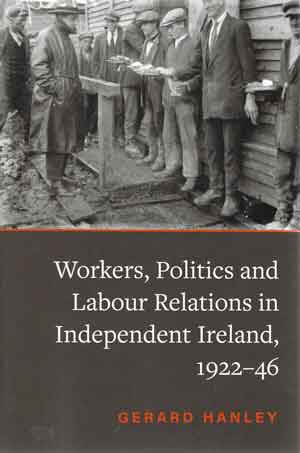
GERARD HANLEY
Four Courts Press
€45
ISBN 9781801510783
Reviewed by Brian Girvin
Brian Girvin is Professor Emeritus and Honorary Professor at the University of Glasgow.
Political independence promises much, but rarely delivers to the most disadvantaged sections in the new state. This certainly proved to be the case for the Irish working class and trade unionists between 1922 and 1932, as this welcome new study on labour relations in independent Ireland shows. Economic and political power remained concentrated in privileged groups, notwithstanding the political changes. While it would be a mistake to say that nothing changed after independence, Gerard Hanley makes a very powerful case that conditions for disadvantaged groups deteriorated after independence.
This book is also an important rejoinder to recent very positive interpretations of Cumann na nGaedheal between 1922 and 1932, emphasising success in state-building, security, economic development and the promotion of Irish culture. While recognising the challenges that the Irish Free State faced, Hanley emphasises that ‘It soon became clear to the working class that political independence did not necessarily mean social and economic independence’. This is illustrated by case-studies of the Post Office workers’ strike, 1922, and the Waterford farm labourers’ strike, 1922–3. Not unreasonably, workers wanted to maintain their living standards and wages against demands by employers to reduce them. In both cases the government characterised the strikes as subversive and the strikers as disloyal, deploying its security forces to break the strikes with coercion and violence. The government denied that the Post Office unions had the right to strike and in the Treasonable and Seditious Offences Act (1925) removed the right to strike for all civil servants. The farm labourers’ strike was a fierce rural class conflict, which ended not only in the defeat of the strikers but also in the collapse of the union. The conflict in Waterford was not unlike that in rural Italy, which contributed to the success of fascism there, though Ireland did remain democratic.
The Shannon Scheme has normally been seen as a success for Cumann na nGaedheal, as in many respects it was. Minister for Industry and Commerce Patrick McGilligan asserted that the State had no responsibility for unemployment or poverty relief. Hanley’s comment on this is telling:
‘The Shannon Scheme demonstrates how little importance the government attached to labour relations, employment conditions and the general welfare of the unskilled working class even when the dangers of civil war had passed’.
The precarious position of labour in the Irish Free State is exposed in great detail in a chapter on unemployment. The author demonstrates that the figures for unemployment are completely unreliable, which meant that a significant number were not registered and therefore could not receive financial support. This was not unusual in a European context after 1923. Ireland, in common with most other states, pursued a policy of austerity, retrenchment, fiscal orthodoxy and the weakening of trade unions.
The second part of the book provides a much more positive picture. The Great Depression destabilised the economic and fiscal consensus that had prevailed since 1923. Fianna Fáil attracted working-class and trade union support by pursuing more progressive and interventionist policies. De Valera’s government introduced the Unemployment Assistance Act (1933), which established a basic income as a right for the unemployed. As a result, the number of registered unemployed rose threefold, which was a much more realistic figure compared to the 1920s. It also exposed the reality of poverty in urban and rural Ireland, which was now being addressed for the first time. Fianna Fáil’s commitment to economic development also provided employment and much-needed investment in a predominantly agricultural country.
Seán Lemass, minister for industry and commerce 1932–48, is the only politician who receives a positive assessment in this study. The most interventionist Fianna Fáil minister, he was also sympathetic to the trade union movement, arguing during the 1943 elections that ‘the era of Fianna Fáil was the era of trade union progress’. Yet this was an uneasy relationship. Lemass was impatient at the disorganised nature of the unions, inter-union disputes and the presence of British-based unions in Ireland. Hanley describes this rather chaotic environment in some detail, while identifying the Trade Union Act (1941) and the Industrial Relations Act (1946), which established the Labour Court, as ‘new beginnings’ for labour relations.
While I share the author’s positive assessment of Lemass and Fianna Fáil, his view that ‘the birth of social partnership’ can be located in this period is open to question. The increase in trade union membership between 1946 and 1955 can in part be attributed to the conciliatory nature of the Labour Court and the willingness of business and the trade unions to negotiate and compromise. However, continuity is the defining feature of the post-war period and there is little change in the nature of labour relations or the behaviour of the divided trade union movement. Throughout this period, Lemass was committed to State management of the economy, including labour relations. It is often overlooked that most of his policy proposals between 1942 and 1947 involved coercion and coordination by the State. For instance, he drafted legislation in 1947 to prohibit strikes in certain sectors of the economy. In my view the origins of social partnership can be more persuasively located in the very different circumstances that Lemass faced when he became taoiseach in 1959.
Notwithstanding this reservation, this book offers a fresh and well-researched assessment of the Irish labour movement and the challenges it faced.
